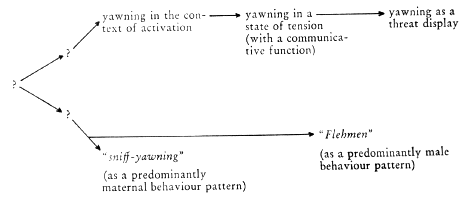 - Summary : Sniff yawning in bovinae
-
- This paper is concerned with a special type
of "Sniff yawning". During a study of the
Banteng, Bos javanicus, in the javanese Nature
Reserve of Udjung Kulon, it was observed that
females and males of these bovines inspected the
skeleton of a conspecific which was devoid of
meat but still smelling.
-
- On these occasions the following behaviour
sequence was regularly observed:
- sniffing and licking of the bones
- raising and stretching forward of the
head
- licking of the nostrils
- yawning
- adoption of normal bearing of the head.
- On exceptional occasions, 1 and 2 were
immediately followed by "Flehmen" or
«lipcurl» and then by the sequence 3
to 5.
-
- In single bulls turning up at the skeleton,
the sequence with sniff-yawning led over to
behaviour which normally occurs in the context
of bull rivalry: horning the bornes, the ground,
or a near bush, and bawling. If several bulls
were together, a lateral threat display was
observed in addition.
-
- Some experiments with several species of
Bovinae in the zoo of Berlin, additional
observations in the zoo and in the wild, and
occasional reports of different authors lead to
the following provisional statements:
- Sniff-yawing occurs in most species of
Bovinae.
- In addition it has been observed in mammals
of very different taxa.
- It is not uniquely a reaction to stimulation
by bones, but to other stimuli as well. Most
often it occurs in the context of special
maternal activities, e. g. licking of amnion
fluid and placenta after parturition and licking
of the offspring.
- Sometimes Flehmen and sniff-yawning occur in
succession, sometimes vicariously. These facts
as well as basic similarities in appearence
suggest that sniff-yawning, similar to Flehmen,
is in its function a special chemoreceptory
process. Although investigations still lack
extensiveness, it is tentatively suggested that
in sniff-yawning as in Flehmen Jacobsons Organ
(Organon vomeronasale jacobsoni) is set in
action. Sniff-yawning would appear as the
predominantly female-maternal variation of
receptory activity involving Jacobsons Organ,
while Flehmen would have to be considered as the
more spezialized male variation. Despite the
similarity between, on one side, yawning in the
context of resting or activation behaviour, on
the other side sniff-yawning, these behaviours
are markedly different from a functional point
of view, while sniff-yawning and Flehmen seem
more closely related.
-
- Based on these considerations the following
phylogenetic relatiuonship is suggested:

- Pandiculation:
the comparative phenomenon of systematic
stretching AF Fraser
- Tous
les articles en allemand sur le
bâillement
|



